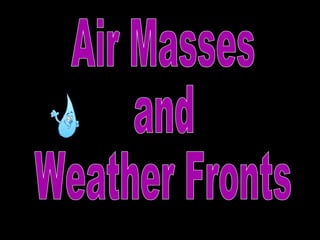Denunciar
Compartir

Más contenido relacionado
La actualidad más candente
La actualidad más candente (20)
Similar a Air Masses
Similar a Air Masses (20)
Chapter 16 2 Air Masses, Fronts And Weather Maps Andie

Chapter 16 2 Air Masses, Fronts And Weather Maps Andie
Chapter 16 2 Air Masses, Fronts And Weather Maps Andie

Chapter 16 2 Air Masses, Fronts And Weather Maps Andie
Air Masses An air mass is a large mass of air that has similar charact.pdf

Air Masses An air mass is a large mass of air that has similar charact.pdf
Más de Janelle Wilson
Más de Janelle Wilson (20)
Air Masses
- 1. Air Masses and Weather Fronts
- 2. An air mass is a large (usually thousands of miles across) volume of air that has the same temperature and humidity. Air masses get their properties from spending days to weeks over the same part of the Earth: Examples: over central Canada, the North Pole, the tropical Pacific Ocean. Describe what the air would be like in each of these places. Warm? Cold? Wet? Dry?
- 3. If the air mass sits over the ocean for a while, it becomes humid (wet) and is called maritime . The air will have high humidity. If the air mass sits over land for a while, it becomes dry and is called continental . The air will have low humidity.
- 4. If the air mass sits near the equator for a while, it becomes warm and is called tropical . If the air mass sits near the poles for a while, it becomes cold and is called polar .
- 5. This means there are 4 combinations: What do you think they will be? Maritime tropical = wet & warm Continental tropical = dry & warm Maritime polar = wet & cold Continental polar = dry & cold Our weather constantly changes because different kinds of air masses are being pushed around the Earth.
- 8. In the USA, the jet stream push air masses from west to east. Therefore our weather generally comes from the west toward Georgia.